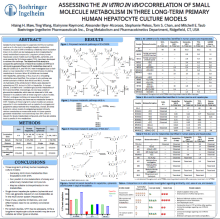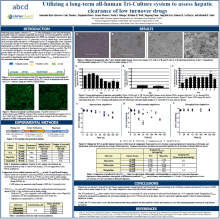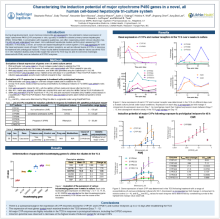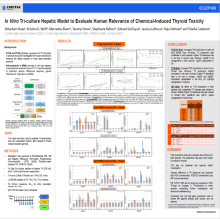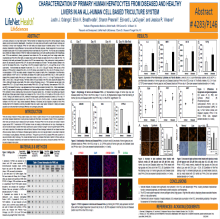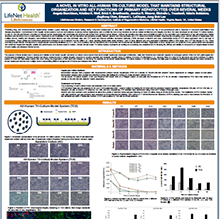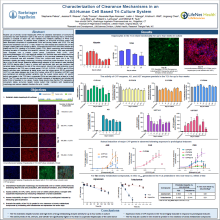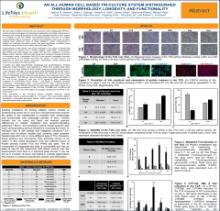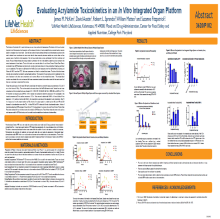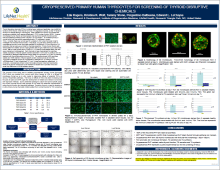TruVivo: Accessing the In Vitro In Vivo Correlation of Small Molecule Metabolism in Three Long-Term Primary Human Hepatocyte Culture Models
The objective of this study is to compare the performance of these three models and suspension human hepatocytes as in vitro tools to generate Phase I and II metabolites observed in vivo. All three systems generated metabolites more extensively than SHH, which is relevant for slowly metabolized compounds, and thus are suitable tools to predict in vivo metabolism.
TruVivo: Utilizing a Long-Term All-Human Triculture System to Access Hepatic Clearance of Low Turnover Drugs
In this study, the TCS (in both 24- and 96-well formats) was assessed for its functionality and its ability to predict human CLhepatic over the course of a 7-day incubation with no media change. The data demonstrate that the TCS predicted CLhepatic that is within 2-fold of actual human in vivo non-renal CL values in both the 24-well and 96-well formats for 2 of 3 compounds tested.
TruVivo: Evaluation of the Activity of Major Drug Metabolizing Enzymes in a Novel All-Human Hepatic Cell-Based Triculture System
The overall goal of this study was to characterize functionality and enzyme activity of major CYPs and UGTs in the TCS over several weeks. Hepatocytes in both 24-well and 96-well formats maintained CYP activity that was generally comparable to that of suspended hepatocytes for as long as 31 days in culture. CYP activity was consistent over 31 days in the 24-well format. In the 96-well format, CYP activity was stable over 21 days.
TruVivo: Characterizing the Induction Potential of Major Cytochrome P450 Genes in a Novel All-Human Cell-Based Hepatocyte Triculture System
In this study, a novel, all-human cell-based hepatocyte triculture system (TCS) was assessed for both the basal expression levels of major CYPs and nuclear receptors, as well as induced levels of CYPs in response to treatment with prototypical inducers. These results define fundamental baseline data for future use of the TCS in in vitro induction studies and provide insight into where the TCS may be able to overcome challenges observed with PHH, such as induction of CYP2C enzymes.
TruVivo: In Vitro Triculture Hepatic Model to Evaluate Human Relevance of Chemical-Induced Thyroid Toxicity
In this study, the triculture system was used to evaluate thyroid hormone perturbation (key and associated events) after assault of known nuclear receptor agonists.
TruVivo: Characterization of Primary Human Hepatocytes from Diseased and Healthy Livers in an All-human Cell-based Triculture System
In this study, the human triculture system was used to characterize basic synthetic and metabolic functions in primary human hepatocytes from healthy and diseased tissues. The results demonstrate that diseased PHHs showed characteristics differences in functionality and lipid disposition compared to normal PHHs indicating that the triculture system represents a promising new platform that can be used to study lipotoxic mechanisms in healthy and diseased populations due to the preservation of phenotypic differences over a prolonged culture period.
Effects of Seeding Density and Exposure Period on Human 3D Thyrocyte Microtissue Formation and T4/T3 Quantitation by ELISA vs LC-MS/MS for Thyroid Disrupting Chemical Screening
The purpose of this study was to further optimize assay conditions of a novel 3D thyroid microtissue model including seeding density and exposure period for TDC testing based on thyroxine hormone production and quantitation using ELISA vs LC-MS/MS methods. Data results indicate that LC-MS/MS provides a superior measure of thyroxine hormone compared to ELISA because of the lower limit of quantification (LOQ) and less error variance. As a result, an optimized treatment regimen requiring fewer primary human thyrocytes per well and a shortened culture period could be adopted for assessment of inter-individual effects of TDCs in sensitive or diseased populations.
Evaluating Acrylamide Toxicokinetics in an In Vitro Integrated Organ Platform
This study demonstrated that the novel Human Dynamic Multiple Organ Plate system can predict Acrylamide (AA) liver and kidney toxicity and provide key ADME date points. These findings indicate that the system can be used as a rapid response model for ADME and toxicity, as well as exploration of metabolites and mechanisms of adverse effects.
TruVivo: Novel In Vitro All-Human Triculture Model That Maintains Structural Organization and Key Functions of Primary Hepatocytes Over Several Weeks
This study demonstrates how a novel in vitro all-human triculture model that maintains structural organization and key functions of primary hepatocytes over several weeks can serve as a better alternative for predicting drug- and chemical-induced hepatotoxicity.
TruVivo: Characterization of Morphology, Longevity and Functionality in an All-Human Cell-Based Triculture System
Results show that the triculture system represents a convenient all-human hepatic culture system that maintains both heptatocellular morphology and metabolic function over several weeks.
TruVivo: Characterization of Clearance Mechanisms in an All-Human Cell-Based Triculture System
In this study, a novel hepatic triculture system was evaluated for basic morphology and functionality, including formation of functional bile canaliculi, albumin (Alb) synthesis, and urea production over a 4-week culture period. The ability of the system to predict in vivo non-renal clearance of two slowly cleared compounds was also evaluated. Results show the triculture system represents a convenient, stable, all-human hepatic culture system that maintains both hepatocellular morphology and various metabolic functions for up to 1 month. The triculture system was also able to predict the hepatic clearance of alprazolam and tolbutamide within 2-fold of reported in vivo values.
Cryopreserved Primary Human Thyrocytes for Screening of Thyroid Disruptive Chemicals
Cryopreserved primary human thyrocytes produced robust and reproducible levels of key thyroid markers and could represent a valuable tool to prioritize TDCs and reveal key differences in MOAs between species.
TruVivo: An All-Human Cell-Based Triculture System Distinguished Through Morphology, Longevity, and Functionality
This novel culture platform represents a convenient, all-human hepatic culture system for toxicological and pharmacological testing applications.
